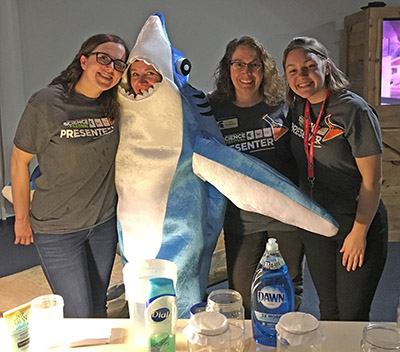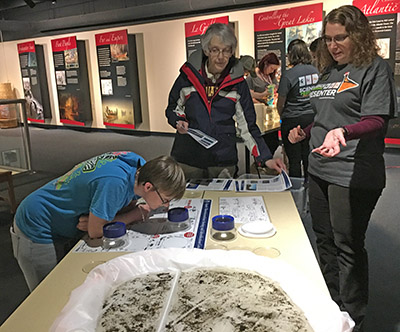Northeast Michigan explores the National Marine Sanctuaries System
Families engaged in science while exploring NOAA’s National Marine Sanctuaries System.

Michigan State University Extension was one of the partners supporting “A Night at the Museums,” a component of the 2017 MSU Science Festival at the Thunder Bay National Marine Sanctuary April 10, 2017. The Thunder Bay National Marine Sanctuary presented an interactive tour of NOAA's (National Oceanic and Atmospheric Administration) National Marine Sanctuary System.
Families from across northeast Michigan engaged in science while they explored the National Marine Sanctuary System at the Thunder Bay National Marine Sanctuary. Over 190 participants dove into science with activities, films and crafts at the Sanctuary's visitor center. Visitors were provided with a Sanctuary Passport and encouraged to explore all 13 sanctuaries at stations set up throughout the exhibit area. Stations featuring hands-on activities and crafts linked to each National Marine Sanctuary site such as dissecting the stomach contents (bolus) of a Laysan albatross, participating in the “Tale of Two Acids” lab experiment to understand ocean acidification, discovering how macro-invertebrates indicate water quality, and filtering micro-plastics from common personal hygiene products.
While youth and adults laughed, learned and explored science, they absorbed the overarching idea that our planet is an ocean planet, and whether you live near the coast or a thousand miles from it, the ocean and Great Lakes are part of your life. From providing the food we eat to determining our weather, the ocean and Great Lakes matter to each of us. The National Marine Sanctuary System protects this vital resource encompassing more than 600,000 square miles of marine and Great Lakes waters.
MSU Extension is a proud partner, along with the Thunder Bay National Marine Sanctuary, of the Northeast Michigan Great Lakes Stewardship Initiative, a network and partnership protecting our Great Lakes and natural resources through hands-on learning in and with the community.
Landshark with staff at the micro-plastics activity (Olympic Coast National Marine Sanctuary).
Participants at the aquatic macroinvertebrate activity (Cordell Banks National Marine Sanctuary and Channel Islands National Marine Sanctuary).
For more ways to share science with youth in your life, please explore the MSU Extension Science and Engineering webpage. For more information about 4-H learning opportunities and other 4-H programs, contact your local MSU Extension office. To learn more about 4-H and Extension opportunities in Alcona County, stop by our Harrisville office at 320 S. US-23 or visit our Alcona County MSU Extension Facebook page.
MSU Extension and the Michigan 4-H Youth Development program help to create a community excited about STEM (Science, Technology, Engineering, and Mathematics). 4-H STEM programming seeks to increase science literacy, introducing youth to the experiential learning process that helps them to build problem-solving, critical-thinking and decision-making skills. Youth who participate in 4-H STEM are better equipped with critical life skills necessary for future success. To learn more about the positive impact of Michigan 4-H youth in STEM literacy programs, read our 2015 Impact Report: “Building Science Literacy and Future STEM Professionals.”



 Print
Print Email
Email





